The Intel Haswell Refresh Review: Core i7-4790, i5-4690 and i3-4360 Tested
by Ian Cutress on May 11, 2014 3:01 AM ESTCPU Synthetic Benchmarks
Content Creation - Cinebench
Based on MAXON’s CINEMA 4D animation software, Cinebench is used to determine the CPU and graphics performance via OpenGL. The software has gone through many iterations over the years, and here we use versions 10, 11.5 and 15 to compare single-threaded and multi-threaded CPU performance. As the generations increase, the software becomes more multithread aware and scales better, however for consistency with older results we keep the version 10 results in our database.
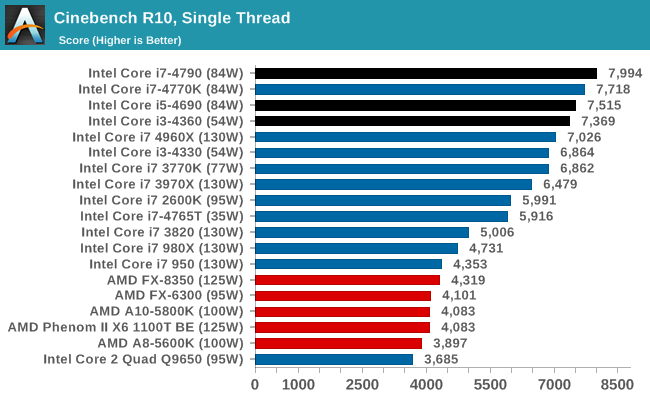

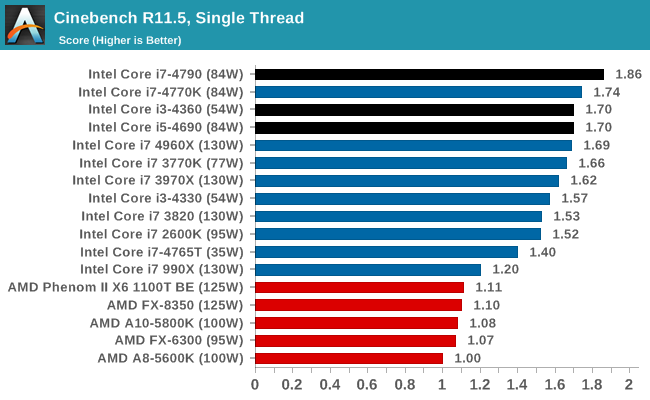
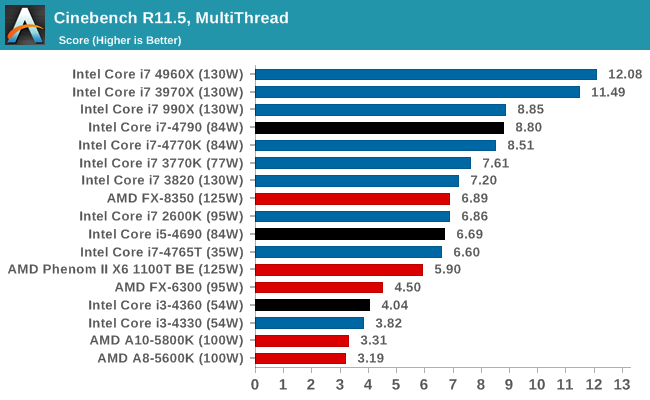

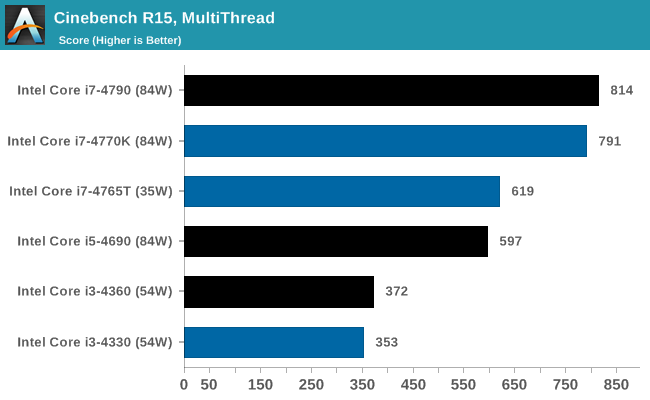
Video Conversion - x264 HD 3.03 Benchmark
Graysky's x264 HD test uses x264 to encode a 4Mbps 720p MPEG-2 source. The focus here is on quality rather than speed, thus the benchmark uses a 2-pass encode and reports the average frame rate in each pass.
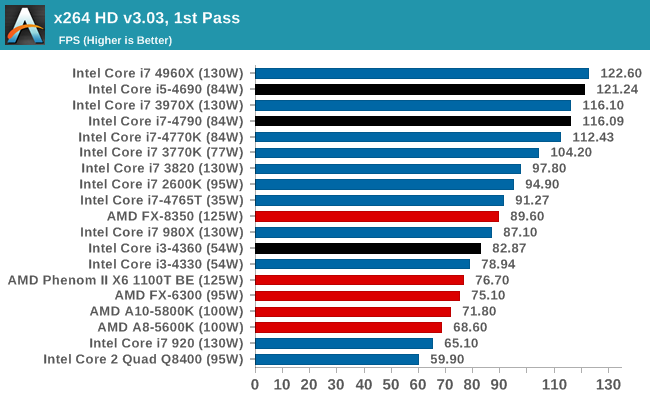

Encryption –TrueCrypt v0.7.1a: link
TrueCrypt is an off the shelf open source encryption tool for files and folders. For our test we run the benchmark mode using a 1GB buffer and take the mean result from AES encryption.
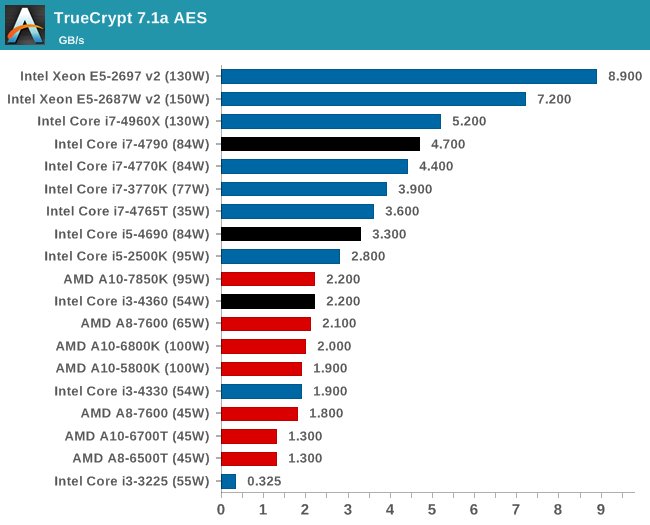
Synthetic – 7-Zip 9.2: link
As an open source compression tool, 7-Zip is a popular tool for making sets of files easier to handle and transfer. The software offers up its own benchmark, to which we report the result.
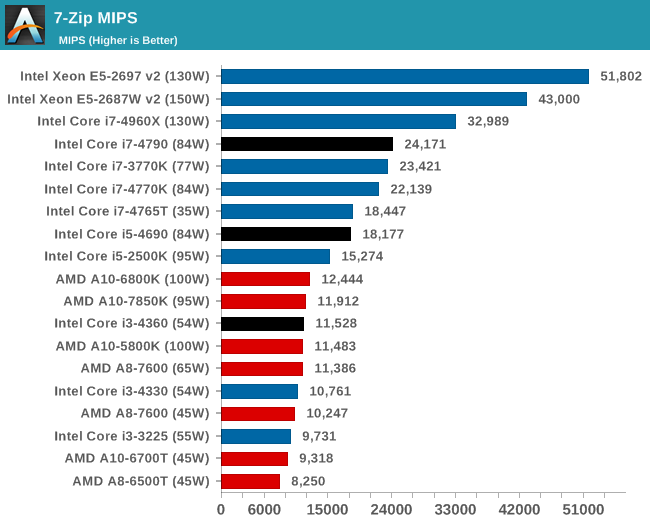
Rendering – PovRay 3.7: link
The Persistence of Vision RayTracer, or PovRay, is a freeware package for as the name suggests, ray tracing. It is a pure renderer, rather than modeling software, but the latest beta version contains a handy benchmark for stressing all processing threads on a platform. We have been using this test in motherboard reviews to test memory stability at various CPU speeds to good effect – if it passes the test, the IMC in the CPU is stable for a given CPU speed. As a CPU test, it runs for approximately 2-3 minutes on high end platforms.
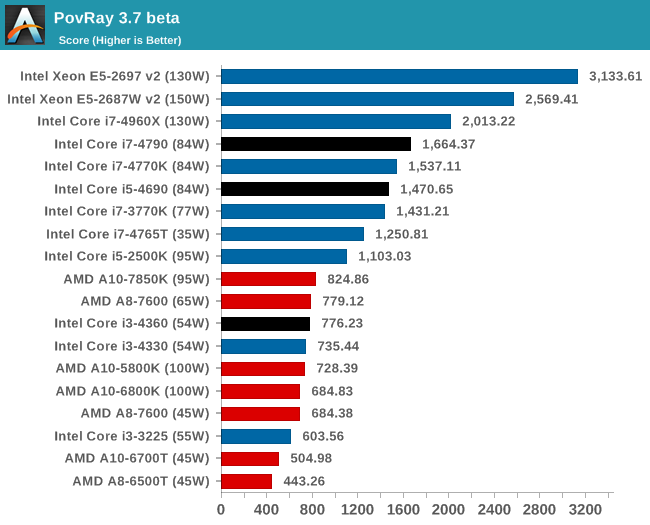
Console Emulation –Dolphin Benchmark: link
At the start of 2014 I was emailed with a link to a new emulation benchmark based on the Dolphin Emulator. The issue with emulators tends to be two-fold: game licensing and raw CPU power required for the emulation. As a result, many emulators are often bound by single thread CPU performance, and general reports tended to suggest that Haswell provided a significant post to emulator performance. This benchmark runs a Wii program that raytraces a complex 3D scene inside the Dolphin Wii emulator. Performance on this benchmark is a good proxy of the speed of Dolphin CPU emulation, which is an intensive single core task using most aspects of a CPU. Results are given in minutes, where the Wii itself scores 17.53; meaning that anything above this is faster than an actual Wii for processing Wii code, albeit emulated.
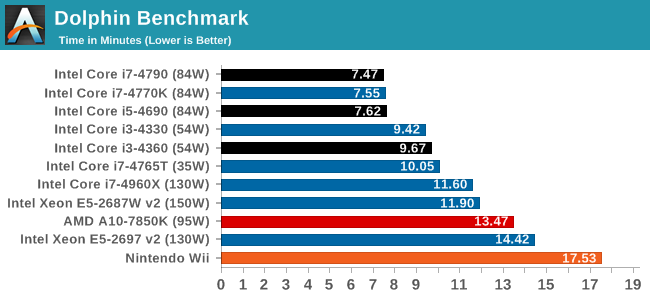
Dolphin relies very much on architecture as well as CPU single thread speed. It would also stand to reason that there is a small about of thread switching going on, given how far off the i3 and i7-4765T CPUs are.










130 Comments
View All Comments
rajod1 - Thursday, May 29, 2014 - link
I agree, waste of cash to upgrade every generation. Old days were nice. Intel said they would hit 10 GHZ by like 2004 or something. LOL. So they hit a wall but still needed cash. Lots of suckers born every minute that will upgrade for 10 percent increase.Hrel - Monday, May 12, 2014 - link
The fact that hyperthreading is disabled on the i5's on the desktop is infuriating. Enabling it costs them nothing. Agree on the 8 core at $300, it should still have HT though.Flunk - Monday, May 12, 2014 - link
Definitely, turn on HT on i5 and give them all 4 cores and offer an 8 core i7 with HT. i3s can soldier on with only 2 cores if they really want to.A i7 5770 with 8 cores and HT is what they really need to bring out, but I think they're waiting for AMD to bring out something better first.
rajod1 - Friday, May 30, 2014 - link
You may as well ask them to drop the I5 because if you put HT on a I5 its then I7.rajod1 - Friday, May 30, 2014 - link
It does cost them something. They sell my I7s that way.bsim500 - Sunday, May 11, 2014 - link
Thanks for this review - appreciate the effort that went into it as always."Also of note is the Z97 motherboard we used for these tests implements an Adaptive voltage profile, meaning that artificial loads such as OCCT push the voltage higher than normal, increasing power consumption at load"
So they've still got that dumb Haswell "feature" of stuffing the Vcore up by +0.1v when you least want it? Also why are your power consumption figures so high in general? My i5-3570 @ 4.0Ghz barely pulls 37w idle / 88w 4-threads prime with a 7870 discrete card (whole system (excluding monitor) measured at the wall). That's roughly 25w lower both idle & load than your i3 (with a 1600MHz idle vs 800Mhz Haswell's)! Just out of curiosity, what where the stock / default VID's like on the i3-4360 / i5-4690? ie, has the clock speed bump increased required voltages much? Thanks.
Ian Cutress - Sunday, May 11, 2014 - link
Adaptive is an Intel specification implementation, but for some reason goes haywire with certain 100% load simulators (OCCT/AIDA).With regards power consumption seeming high:
a) Low efficiency band of the PSU. Hence me stating qualitative analysis more relevant than quantitative. Need to keep the PSU consistent across all the tests, some tests require 2x/3x GPUs (e.g. X79). This is probably a large part of it, but all tests are therefore done on the same efficiency curve.
b) Using a Corsair H80i with two fans and ODD plugged in. I move the USB devices to USB 2.0 so any USB 3.0 controller can power down, but it still all adds up.
c) OCCT loading does the adaptive voltage thing, causing more power consumption at load from idle.
We got ES chips to test, so retail might have adjusted slightly on the stock VID. Also VID can differ from chip to chip in the same bin, so it's not really a good measure. One CPU can have a high VID in the bin, while the next bin up we could get a low VID, and it all look a bit odd.
Daniel Egger - Sunday, May 11, 2014 - link
IMNSHO it is really ridiculous to test all systems with the same outlandish special PSUs that no sane person would ever use. Why not have a testbed for single card systems with say a platinum 500W PSU (which should cover even the nasty R295X2 plus a Haswell K processor) and a separate one for crazy setups? With those far sub 20% loads even under full load it is nearly impossible to get useful readings not to mention comparable ones since at these low loads lots of funny effects kick in skewing the results...wetwareinterface - Sunday, May 11, 2014 - link
The reason you don't have a low end psu on your test bench is it's a test bench.The one setup should handle anything you can possibly throw at it and then a little extra for good measure.
Also having the exact same high wattage psu to test everything on eliminates the psu as a differentiating factor when testing multiple system configurations.
and finally the sad truth is there are several reviewers working for anandtech each from home and each with whatever they have laying around to do said testing with...
Daniel Egger - Monday, May 12, 2014 - link
> The reason you don't have a low end psu on your test bench is it's a test bench.The one setup should handle anything you can possibly throw at it and then a little extra for good measure.
Exactly my point for suggesting a 500W PSU rather than something much lower that I would personally put into a build. That should be sufficient for any even just halfway reasonable setup.
> Also having the exact same high wattage psu to test everything on eliminates the psu as a differentiating factor when testing multiple system configurations.
Unfortunately that's not true. Very low output on high wattage PSUs skews the results quite a bit because they typically are not accurate enough when it comes to handling the low loads thus smearing over the results with their own losses. I assume this is also why our Greek friend here doesn't even bother to test loads below 5% (which would be 60W at a 1200W PSU, about twice as much as my current Haswell PC needs on an mostly Idle Windows desktop).